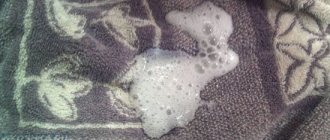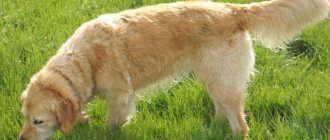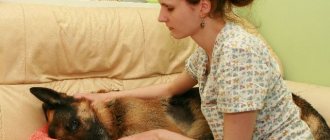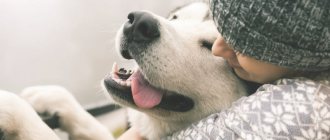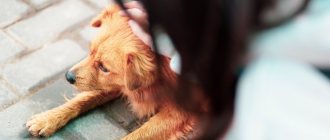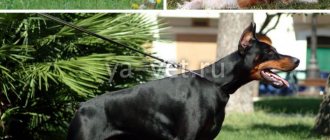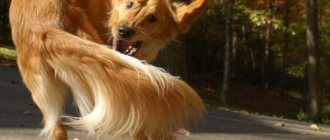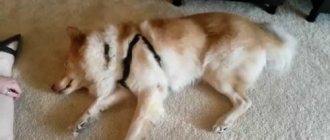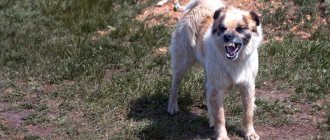If a dog has damaged a nail, every owner should know how to stop the bleeding. There are simple methods that do not require special training.
Most often, damage to the living part of the claw occurs during trimming. There are also cases when the dog itself is injured. In any case, in case of damage of various kinds, measures must be taken. Methods to stop bleeding will depend on the location.
Every owner should know how to provide first aid, for example, if a dog’s tooth is bleeding, or how to stop it if there is a pulp injury. It is worth noting that the actions will be completely different. In the first case, you just need to temporarily press the gum with a cotton swab. But you can’t do that with a paw. The fact is that the pulp (the living area of the claw) is quite sensitive and when cut it hurts a lot. Therefore, it is not recommended to put pressure on it under any circumstances. The dog simply won’t let you do this; it will bite and break free. But don't panic. It is also possible to stop bleeding in this area. The article will present effective methods that will be painless for your pet, and he will calmly withstand the procedure.
Structure of the claw
Before you learn how to stop bleeding, you need to understand the structure of the claw. It consists of two parts. The first is the outer hard shell. Inside it there is a spongy part called the body. In appearance it differs from the hard shell, primarily in color. This spongy material has a light pink tint. The inner part contains blood vessels and nerve fibers. This is why bleeding may begin if the claw is cut too high. Its intensity varies: from weak to abundant. However, there is no need to worry ahead of time. As a rule, a small wound does not pose a danger to the animal. All you need to do is stop the bleeding. Read on to find out how to do this.
Is a haircut often necessary?
You are unlikely to hear a clear and unambiguous answer on the frequency of trimming nails even from a veterinarian. The age of the animal, its lifestyle, the level of street activity and the surface on which the dog moves most of the time are taken into account.
The comfort of apartments with their laminate, linoleum or parquet means that the dog’s nails will have to be trimmed quite often.
With an active outdoor lifestyle, with walking on hard surfaces, the dog will not need frequent nail trimming. In this case, the natural grinding process will correct everything itself.
global $ads_google; //data-ad-slot=”2475549904″ $ads_google = empty($ads_google) ? false : true; ?> if ($ads_google == false) {?>
$ads_google = true; ?> } ?>
Veterinarians can answer in more detail: the blood vessels that are in the claw grow with it. The less often you cut, the easier it will be to damage the vessel. The dog will definitely not appreciate such “care” then.
How to trim a dog's nails correctly
In order not to think about how to stop a dog’s nails from bleeding, you need to know how to cut them correctly. Many owners are interested: “Why do this and do animals need a manicure at all?” Dogs' nails must be shortened. The fact is that they can grow into the skin, and this will cause severe infection.
How to trim claws correctly? To do this you need to have special scissors. For large breeds they are suitable with a sickle-shaped blade, and for medium and small breeds - with a “guillotine”. Next you will need to inspect each claw. If the dog has white teeth, then it will not be difficult to determine the length of the pulp. The situation is somewhat more complicated with black claws. Only the sharp ends can be trimmed. This will ensure that the living area is not affected.
After finishing trimming, it is recommended to file the nails with a nail file. This is especially important if the cuts are uneven. In such places they will begin to peel off over time, and this is extremely undesirable.
First Step: Stay Calm
The first thing you should remember after your dog's nail bleeds is to remain calm. If you panic, you will make your dog panic too, so try to remain calm. The bleeding will look much worse than it actually is. The calmer you remain, the calmer you can hold your dog.
If you cut your dog's nail too short, the nail will bleed and your dog will likely scream. Bleeding may be profuse and prolonged. Stay calm, speak in a soothing voice, and immediately give your dog a bunch of tasty treats.
Most nail trimming accidents are minor and can be treated at home. If you have another person, enlist their help; another set of hands will make the process much easier.
© shutterstock
How to stop a dog's nail from bleeding: five proven methods
Damaged nails in dogs are common, so experienced owners have already tried many ways to stop the bleeding. Let's look at the ones that are truly effective and veterinarian approved.
- Using a pencil.
- Using soap.
- Potassium permanganate compress.
- Flour paste.
- Baking soda or cornstarch.
It is important to understand that these methods are useful only in non-critical situations. If the animal has long and heavy bleeding, then no self-medication, only a visit to the veterinarian.
Styptic pencil
How to stop bleeding from a dog's nail using a special pencil?
Sequencing:
- Prepare the dog's paw.
- Wet the tip of the pencil.
- Secure the paw with the damaged claw.
- Place a pencil into the wound and hold it in this position for 2 minutes.
If the claw continues to bleed, the procedure can be repeated. However, the second time you will need to hold the pencil longer - up to 5 minutes. If this does not help, then you should immediately contact the clinic.
At the moment, a hemostatic pencil is considered the most effective means for stopping bleeding. It is recommended by veterinarians. It is sold freely in specialized pharmacies.
Fast wound healing
CONDITIONS
- The wound must be clean, free of foreign matter, dirt, particles, and non-viable tissue;
- The wound should not be infected;
- The wound should not remain open and in contact with the environment;
- Healing should occur in moderately
moist environment.
And now, in order: Condition of the wound.
It should not contain foreign particles, dirt, or non-viable tissue.
Any dirt, clotted blood and pus must be removed, that is, the wound must be treated and washed. Hydrogen peroxide, saline solution, or, in extreme cases, just clean water will do. If the wound is chronic, poorly healing with a dry, poorly detachable bottom (eschar), it is necessary to use a special gel ( Fibrogel Ag
or
Intrasite gel
) in combination with a secondary absorbent dressing (Allevyn Adhesive, Non Adhesive), or in combination with a breathable film dressing (Opsite FlexiFix , Opsite Flexigrid). However, if you have a deep chronic wound, we recommend that you first seek help from specialists.
Presence of infection.
The presence of an infectious process in the wound negatively affects the healing process.
If measures are not taken, the wound may become chronic, as a result of which the healing process may take a long period. It has long been proven that silver has a pronounced antibacterial effect, due to which the use of silver-containing dressings significantly helps to block the growth of bacteria and the development of infection in the wound. If there is an infectious process, it is necessary to use a bandage with silver nanocrystals (Acticoat or Acticoat 7); Neofix Fibrotul Ag
. Matching headbands are here.
Closing the wound.
The wound must be protected from environmental influences and infection. If the wound is small, an abrasion or a scratch, it is enough to treat it with a special film spray (Opsite Spray) or cover it with a breathable film bandage (Opsite FlexiFix, Opsite Flexigrid). The dressing for wounds of medium size and depth should be sterile, impervious to moisture and microorganisms from the outside, and also facilitate the absorption of exudate and removal of excess moisture (Neofix Post, Opsite Post Op, Opsite Post Op Visible).
Humid environment.
It was previously believed that for a wound to heal quickly, it should be as dry as possible, but modern experience shows that for successful and rapid wound healing, a moderately moist environment must be maintained in it. In a humid environment, enzymes and growth factors are most active and cell growth and reproduction are more active, but excess moisture must be removed. Optimal moisture in the wound is maintained with breathable patches (Neofix Post, Opsite Post Op, Opsite Post Op Visible) when there is little exudate, or sponge dressings when there is a lot of discharge (Allevyn Adhesive, Non Adhesive).
WHAT TO DO?
- Assess the wound. Large, deep, bitten, scalped, lacerated wounds and wounds with heavy bleeding require qualified medical care; self-medication in this case is dangerous.
- Clean the wound - rinse with hydrogen peroxide, it will help remove small foreign objects, particles of dirt, non-viable tissue, and blood clots from the wound. If there is no hydrogen peroxide, then you can simply wash the wound with water or saline;
- Treat the edges of the wound. In this case, iodine or a solution of brilliant green (brilliant green) is suitable. To prevent wound infection, you can use a silver-containing dressing, Neofix Fibrotul Ag, fixing it on the wound with a patch or film type bandage (Opsite FlexiFix, Opsite Flexigrid);
- You can also simply cover the wound after treatment with a non-stick, breathable, moist dressing. Or a patch with the same properties. In this case, any adhesive bandage on a non-woven or film base (Neofix Post, Opsite Post Op) is suitable.
If the wound is small, then you need to do the following:
CONCLUSION OF WOUND EDGES
For additional fastening of the edges of a sutured wound, as well as for bringing together the edges of an incised wound after treatment, you can use LEUKOSTRIP adhesive strips. They reliably fix the edges of the wound, allow air to pass through, and remove excess moisture.
SUPERFICIAL WOUNDS, EXTENSIVE Abrasions
To ensure healing of a superficial wound, non-adhesive mesh dressings containing paraffin (Jelonet) are used as the primary wound covering. If there is a risk of wound infection, as well as to prevent infectious complications, a mesh dressing containing soft paraffin and an antiseptic (Bactigras) can be used as a primary wound covering. To remove excess fluid (exudate), an absorbent secondary layer is applied over the mesh bandage - a sponge bandage (Allevyn Adhesive, Allevyn Non Adhesive). Fixation can be achieved using a breathable film bandage (Opsite Flexifix, Opsite Flexigrid).
WOUNDS ON THE FACE
Wounds on the face require a special approach, since wound healing should lead to minimal cosmetic defects. For additional reduction of the edges of the wound, if the wound is sutured, or as a primary dressing, you can use special adhesive strips - strips (Leukostrip). The range of leading manufacturers of plasters includes a large number of simulated bandages (cut to size), with which you can carefully close the wound. If a scar has formed after healing, you can use a special silicone bandage that is designed to reduce and eliminate scars (Cica-Care). You can buy Cica-Care silicone patch here.
POST-OPERATIVE WOUNDS
We recommend covering postoperative wounds with specialized dressings. The structure of the dressing provides a favorable environment for healing and its painless change when dressing. Thanks to the inner layer, the bandage is securely fixed to the skin, but later it can be easily and painlessly removed. The middle, absorbent layer, consisting of viscose or polyurethane foam, ensures quick and reliable removal of exudate. The outer film or non-woven layer ensures rapid and constant evaporation of excess moisture. Among non-woven based dressings, we recommend using Neofix Post and Primapore. Among film-based dressings, Opsite Post Op and Opsite Post Op Visible have proven themselves to be excellent.
PURPUS WOUNDS
The presence of pus in the wound indicates that an infectious process has begun. Treatment of purulent wounds, especially large and deep ones, requires qualified medical care and an integrated approach. For such a case, we can recommend the following dressings: - For cleaning a wound with a dry, poorly detachable bottom (scab), or in the presence of a dense fibrin film at the bottom of the wound, hydrogel (Intrasite Gel) has proven itself very well. It must be applied to the surface of the wound, and then covered with a secondary film or sponge bandage. After 48 hours, the wound needs to be washed and cleaned. — For the treatment of purulent wounds, dressings with silver nanocrystals (Acticoat and Acticoat 7) have proven themselves to be excellent. Silver, acting as an antiseptic, is released gradually, providing a long-lasting and permanent effect. Acticoat dressing can be left on the wound for up to 3 days, Acticoat 7 for up to seven days. These dressings are primary; after application to the wound, they must be covered with a secondary absorbent dressing. Before use, silver-containing dressings must be moistened with distilled water or water for injection. Go to CATALOG OF BANDAGES
Antibacterial soap
How to stop a dog's nail from bleeding using soap? This does not require complex manipulations. It is enough to take the animal’s paw and press the soap with the damaged claw. During this procedure, the wound is closed with a kind of plug, which disappears on its own after 3-4 hours. To form it, the claw must be immersed in soap by approximately 2-3 mm. Then fix this position for 3-4 minutes.
It is important to hold the claw clearly perpendicular when pressing the soap. The dog may not like this action and will begin to struggle, so be sure to hold it tightly during the procedure. It is recommended to remove soap from the claw carefully, since this area is very sensitive for the animal.
Use of Potassium Permanganate
How to stop bleeding in a dog at home? For this you can use potassium permanganate. What is this substance? Powder of small crystals of dark purple color. This method is recommended by veterinarians. Most often, this is how clinics stop bleeding from a claw.
What will be needed for the procedure?
- Some warm boiled water.
- Potassium permanganate itself.
- Cotton swabs.
The procedure itself is simple. You will need to dilute potassium permanganate in water. Afterwards, take the prepared swab, dip it in the solution and apply it to the wound. Hold for about 30 seconds. Next, see if the bleeding has stopped. If this does not happen, then the procedure is repeated. The tampon is reapplied for 5 minutes.
Baking soda
If you are interested in how to stop a dog’s bleeding at home after trimming its nails, then you can use baking soda for this purpose. The method is very simple. A paw with a damaged claw should be dipped in soda. Due to the fact that the place is oozing, a clot will form on it. It will stop the bleeding. This plug will fall off on its own after 40 minutes, so no other manipulations will be required.
Preventing claw bleeding
Let’s talk right away about preventing such a phenomenon. A claw fracture or other damage to it is a pathology that is quite painful and fraught with infection of the damaged area. Therefore, it is better to prevent it:
- Claws must be trimmed if they begin to protrude beyond the foot by at least a millimeter.
- You should walk your dog daily, alternating types of roads. It is useful for a dog to walk both on the ground and on asphalt, especially if the walks are not too long: on hard surfaces, the claws wear down naturally, which prevents many problems later.
- After each walk, you need to carefully examine your paws. During the period of applying reagents to roads, the dog’s limbs should also be washed with warm water and baby soap.
How to Transport Your Dog to the Vet If the Bleeding Won't Stop
In most cases, bleeding after nail trimming does not pose a danger to the animal. However, there are situations when the methods described above do not help. The owners begin to worry about the pet and go to the veterinary clinic. It is advisable that the dog does not walk on its own, as it has an open wound on its paw. An infection can easily get there, which will significantly worsen the animal’s condition. So, what is the correct way to transport your dog to the clinic for a veterinary appointment?
- The first step is to prepare a cotton swab and place it on the wound.
- Next, bandage the paw. To prevent the bandage from falling off along the way, it is advisable to use self-adhesive tape to secure it. There is no need to over-tighten the paw. This may cause discomfort to the animal, and it will try to pull off the bandage. Also, with tight bandaging, the painful spasm intensifies. This must definitely be taken into account.
- A dog in this state may be nervous, so a sedative will not hurt it.

